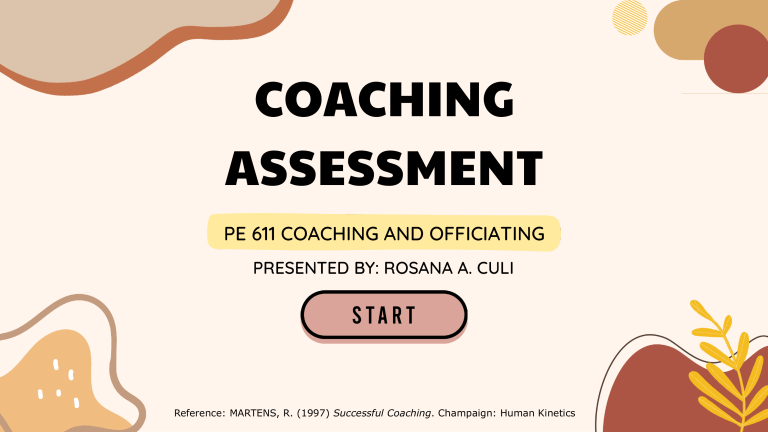
COACHING ASSESSMENT PE 611 COACHING AND OFFICIATING PRESENTED BY: ROSANA A. CULI Reference: MARTENS, R. (1997) Successful Coaching. Champaign: Human Kinetics COACHING ASSESSMENT Martens (1997)[1] identified five critical areas that coaches should focus on coaching objectives, coaching styles, evaluating and developing communication skills, principles of reinforcement and understanding motivation. Coaches are responsible for conducting themselves and their services according to professional and ethical standards, promoting their interests and protecting their performers' rights, the sport and the coaching profession. MARTENS, R. (1997) Successful Coaching. Champaign: Human Kinetics AREAS OF ASSESSMENT Reference: MARTENS, R. (1997) Successful Coaching. Champaign: Human Kinetics 1. 2. 3. HEALTH AND SAFETY COMMUNICATION SKILLS COACHING SKILLS 4. INTERPERSONAL SKILLS 5. LONG AND SHORT-TERM PLANNING 6. TRAINING SESSION CONTENT AND STRUCTURE 7. KNOWLEDGE AND EXPERIENCE 8. CONTROL OF ATHLETES 9. MONITORING OF ATHLETES 10. LEVEL OF FLEXIBILITY COACHING ASSESSMENT PRE-SESSION ACTIVITIES SESSION ACTIVITIES POST-SESSION ACTIVITIES Reference: MARTENS, R. (1997) Successful Coaching. Champaign: Human Kinetics PRE-SESSION ACTIVITIES The following are points to monitor: •Were facilities checked for safety •Was a phone point identified - in case of emergency •Was the First Aid person known - in case of emergency •Was appropriate equipment selected •Were equipment and facilities checked for health and safety •Was the status of each athlete's health checked - injuries, colds, tired etc. •Was there a clear plan of work and objectives for the session •Was each athlete checked to determine what exercise they had completed that day - e.g. school football match - for potential impact on the planned training session Reference: MARTENS, R. (1997) Successful Coaching. Champaign: Human Kinetics SESSION ACTIVITIES The following are points to monitor: •Were athletes made aware of the rules and code of conduct for the activity, and their understanding checked •Was the body language and tone of voice appropriate when giving instructions and advice •Were positive feedback and appropriate corrective action provided to each athlete •Were athletes allowed to ask questions •Were appropriate coaching methods used in developing each athlete •Were athletes observed throughout the session, and appropriate feedback on strengths and weaknesses provided •Did all athletes undertake an appropriate warm-up and cool-down •Did the coach show the appropriate and correct use of coaching skills, e.g. Instruction, Explanation, Demonstration, Observation, Analysis and Feedback Reference: MARTENS, R. (1997) Successful Coaching. Champaign: Human Kinetics POST-SESSION ACTIVITIES The following are points to monitor: •Did the coach have control of the athletes •Did the athletes enjoy the session •Did the coach exhibit a clear understanding of the techniques and skills required by the athletes for the session •Did athletes trust and respect the coach •Did the coach provide appropriate feedback to the athletes •Did the coach use good communication skills •Did the athletes achieve their objectives from the session •Were the coach's objectives for the session achieved •Were the coach's relationship and behaviour with the athletes in line with good practice •Did the coach analyse what worked well, what did not and how it might be corrected •Did the coach ensure the appropriate people collected the athletes Reference: MARTENS, R. (1997) Successful Coaching. Champaign: Human Kinetics




